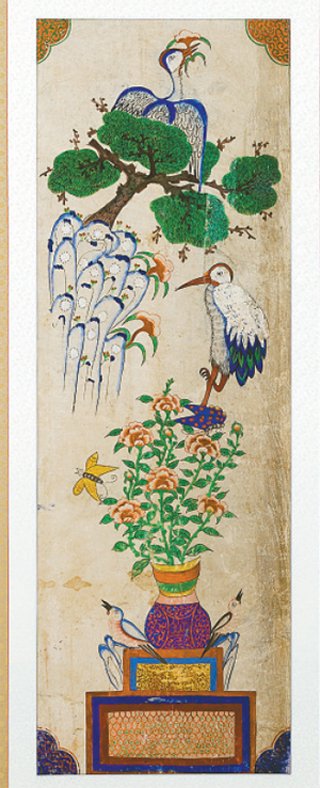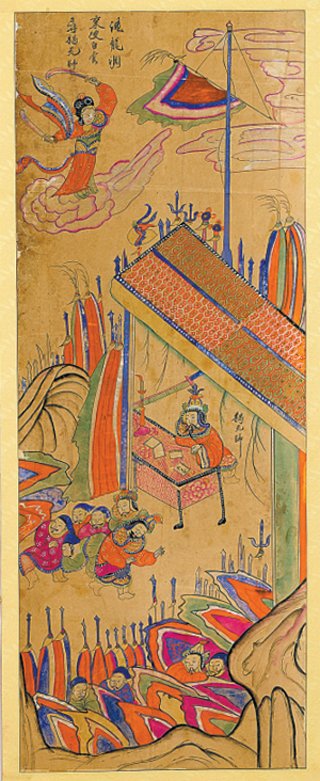Folk painting 'pop music' of art

A 20th-century folding screen that depicts a hunting scene is one of the folk paintings on display at the Horim Museum. Provided by the museum
The dragon - which often symbolizes authority or a king - is portrayed in a funny and satirical manner. The nose is noticeably oversized, shaped like that of a pig. The cintamani, which is the key of a dragon painting and often drawn in or near the dragon's mouth - is floating around freely. This is from a 19th-century painting titled "Clouds and Dragon".
In the final years of the Joseon Dynasty (1392-1910), the order that revolved around the rigid caste system and dominated the society ceased to exist and consumerism spread. This is when minhwa - folk painting - flourished. Between the late 19th century and the early 20th century, common people paid artists to make paintings to decorate their houses or special events. Minhwa, in direct translation, is a painting made by common people, and is the opposite of muninhwa, or painting made by aristocrats.
Many existing folk paintings feature flowers and birds.
The Sinsa branch of Horim Museum is holding an exhibition titled "Korean folk painting" in which it is showcasing some 80 best of the best minhwa in its 30-year collection. Although there have been smaller-scale minhwa exhibitions, the museum officials say this is the first large-scale minhwa exhibition.
The Horim began 30 years ago in a small property in Daechi-dong, southern Seoul. Today it has grown into a museum with 15,000 artifacts, including 54 state-designated cultural properties.
Along with Leeum, Samsung Museum of Art in Hannam-dong, Yongsan, the Horim is considered one of the best private art museums in Korea and one of the few with the financial strength to buy good artifacts when they become available on the market.
"If muninhwa is the classical music, minhwa is the pop music", said Park Jun-yeong, one of the curators at the museum. "Their themes are common and universal, mostly about people's hope for happiness". He was standing next to a 19th-century, 10-part folding screen titled "Children", which depicts children playing various games against a colorful backdrop. The children can be seen playing a "king game" in which one assumes the role of a king, he pointed out.
The exhibition is divided into three parts.
In the first part, titled "nature comes into the canvas", there are drawings whose motifs are flowers, birds and fish. The museum officials explain that minhwa depicting flowers and birds are the most dominant in minhwa found today, and that minhwa of nature were often placed in women's quarters in hopes of a happy marriage.
Old tales are a common motif, like this one from the novel "Gu Un Mong".
The second part is titled "books and letters on the canvas", and showcases drawings of a study and calligraphy. There was a whole genre dedicated to such paintings during the highly-scholarly Joseon era and they were known as chaekgeori (drawings of books and study rooms) or munbangdo (drawings of stationery).
In the third and the last part, dubbed "ancient tales on the canvas", there are drawings of landscapes like scenic Mount Kumgang in today's North Korea, as well as ancient tales like the one based on the 18th-century novel by Kim Man-jung, called "Gu Un Mong", which is about a protagonist named Seong-jin and his life.
Further, visitors can enjoy a screen that has one painting on one side and a different painting on the other side. The exhibition also displays some other artifacts - like ceramics and stationery - that feature folk paintings alongside the minhwa pieces.
The curators say in most of the cases, the artists that made these paintings are unknown, but sometimes, they can find a little stamp sign which indicates the painter's name.
"It's interesting how many of these were used as wallpapers or screens at average people's houses", Park said. "There is still a very large minhwa community in Korea, with many people still learning it", he added.
Admission to "Korean Folk Painting" at the Sinsa branch of Horim Museum is 8,000 won ($7.23). Hours are between 10:30 a.m. and 6 p.m. The museum closes every Monday. It's near Sinsa Station, subway line No. 3, but not at a walkable distance. For more information call 02-541-3523 or visitwww.horimartcenter.org.
By Kim Hyung-eun [[email protected]]
Source from :koreajoongangdaily.joinsmsn.com


